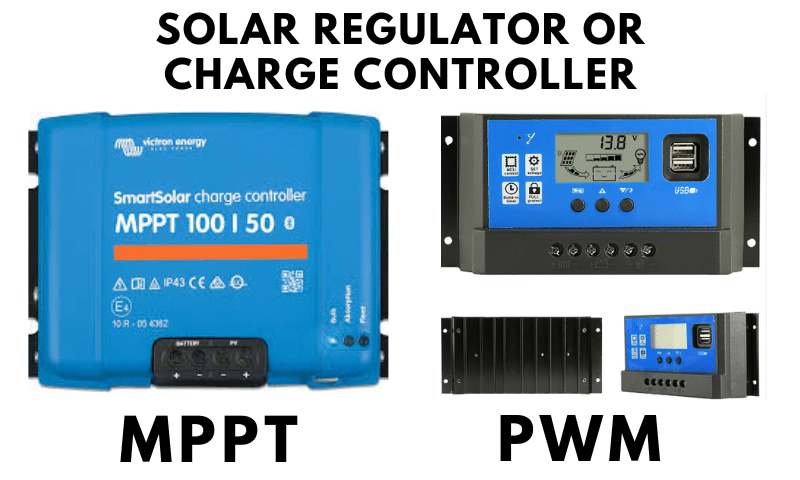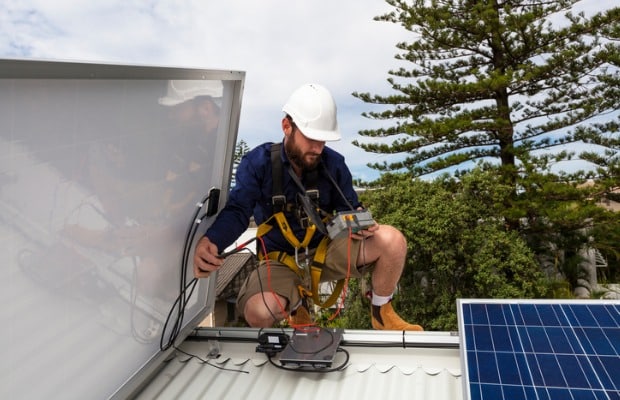
On This Page
In Australia, solar energy is becoming increasingly popular as a source of renewable power for homes and businesses. However, one of the key components of a solar power system that is often overlooked is the solar regulator or charge controller. In this article, we’ll take a closer look at what a solar regulator or charge controller is and why it’s an essential component of any solar power system.
If you’re considering incorporating solar energy into your home or business, it’s essential to receive tailored advice and quotes from reputable providers. Energy Matters, a trusted name in the renewable energy sector, can help you navigate the complexities of solar solutions. We offer FREE solar quotes to assist you in making informed decisions about your solar power system.
Energy Matters has been a leader in the renewable energy industry since 2005 and has helped over 40,000 Australian households in their journey to energy independence.
Let us discuss and choose the best quote that suits your needs and budget, and we can connect you with our trusted local installers, who will provide up to 3 FREE quotes for your home and business solar energy system.
What does a solar regulator do?
A solar regulator (or charge controller) works in conjunction with a stand alone (off grid) system, or a grid connected solar power system that incorporates a backup battery bank. For a grid connected solar power system that doesn’t use batteries, a solar regulator is unnecessary.
A solar regulator is a small box consisting of solid state circuitry that is placed between a solar panel and a battery. Its function is to regulate the amount of charge coming from the panel that flows into the deep cycle battery bank in order to avoid the batteries being overcharged. A regulator can also provide a direct connection to appliances, while continuing to recharge the battery. That is, you can run appliances directly from it, bypassing the battery bank; but the batteries will continue to be charged.
Modern solar regulators are very efficient and will outperform just about any 3 stage mains power battery charger.
How does a solar regulator work?
A solar regulator is a device that regulates the voltage and current coming from solar panels to the battery or inverter. It protects the battery from overcharging and ensures it receives the optimal energy from the solar panels. This, in turn, extends the life of the battery and ensures that the solar energy system operates efficiently.
What solar regulator do I need for my solar panel?
In Australia, there are two types of solar regulators commonly used: PWM (Pulse Width Modulation) and MPPT (Maximum Power Point Tracking).
PWM (Pulse Width Modulation) regulators
PWM regulators are more affordable and work by gradually reducing the current from the solar panels as the battery charges, thus preventing overcharging. However, they are less efficient than MPPT regulators, which are more expensive but can convert excess voltage into usable current.
MPPT (Maximum Power Point Tracking) regulator/controllers
MPPT regulators are capable of tracking the maximum power point (MPP) of the solar panel array, which is the point at which the solar panels produce the most power. By tracking the MPP, MPPT regulators can optimise the amount of energy harvested from the solar panels, even in varying weather conditions.
Solar regulators in Australia are subject to strict regulations and standards to ensure they are safe and reliable. They must comply with the Australian Standard AS/NZS 5033, which sets out the requirements for the installation of photovoltaic (PV) arrays, including solar regulators. This standard ensures solar regulators meet Australian safety standards and operate effectively in the Australian climate.
It is important to choose the right solar regulator for your solar energy system, considering factors such as the size of your solar panel array, the battery capacity, and your energy consumption patterns. A qualified solar installer can help you choose the right solar regulator for your specific needs.
When choosing a solar regulator, it is important to consult with a qualified solar installer to ensure that you get the right regulator for your needs.
Here are some additional factors to consider when choosing a solar regulator for your solar panel in Australia:
- The voltage and amperage of your solar panels
- The type of battery you are using
- The climate you live in
- The features you want, such as temperature compensation, load control, and remote monitoring
Is a solar regulator the same as a solar controller?
A solar regulator (or solar panel regulator) and a solar controller are the same in Australia. However, there is a slight technical difference between the two. A solar regulator is a device that regulates the voltage and current coming from solar panels to the battery or inverter. It protects the battery from overcharging and ensures it receives the optimal energy from the solar panels. On the other hand, a solar controller is a more advanced device that can track the solar panel’s maximum power point (MPP). This means it can extract more power from the panels, resulting in a more efficient solar system.
In general, most solar systems in Australia use MPPT solar controllers. MPPT controllers are more efficient and can save money on energy bills. However, a PWM solar regulator may be more affordable if you have a small solar system or are on a tight budget.
The best way to decide whether you need a solar regulator or a controller is to consult a qualified solar installer. They can help you assess your needs and recommend the right product for your system.
Where is the best place to put a solar panel regulator?
The best place to put a solar regulator is as close to the battery as possible. This is because the longer the cable runs between the regulator and the battery, the more voltage drop there will be, which can reduce the solar system’s efficiency. The regulator should also be mounted in a cool, dry place, out of direct sunlight. A good option is to mount it inside a shed or garage or in a protected area under a house.
Here are some of the factors to consider when choosing a location for your solar regulator:
- Proximity to the battery: The closer the regulator is to the battery, the less voltage drop there will be.
- Cool, dry location: The regulator should be mounted without exposure to extreme temperatures or moisture.
- Protected from the elements: The regulator should be mounted without exposure to direct sunlight, rain, or snow.
- Accessible for maintenance: The regulator should be mounted where it is easy to access for maintenance and repairs.
Following these guidelines ensures that your solar regulator is installed in the best possible location for optimal performance and longevity.
Here are some additional tips for installing a solar regulator in Australia:
- Use heavy-duty cables to connect the regulator to the solar panel and battery.
- Insulate the cables to prevent heat loss.
- Install a fuse or circuit breaker to protect the regulator from overloads.
- Label all of the cables to make it easy to troubleshoot any problems.
By following these tips, you can ensure that your solar regulator is installed safely and correctly.
Selecting a solar regulator
A solar regulator or charge controller is essential to any solar power system in Australia. It regulates the flow of electricity from the solar panels to the battery, ensuring that the battery is charged safely and efficiently. When selecting a solar regulator or charge controller, it’s important to consider the size and type of your solar panels, the capacity and type of your battery, and the features and capabilities of the regulator. By selecting the right regulator for your system, you can ensure that your solar power system operates safely and efficiently for years to come.
To determine the size regulator you’ll require, check the amp ratings of your solar panels and add those figures up and that will give you the minimum size charge controller you’ll need – or you can use our system builder tool, which will tell you the size you’ll need based on various selections.
When selecting a solar regulator, it’s important also to look ahead. If you think you’ll be adding to your system, it pays to buy a regulator rated as high as possible. This can save you money when you add additional solar panels.
Low voltage disconnect
Some charge controllers include a Low Voltage Disconnect (LVD) feature. This monitors the battery level and will disconnect any load connected to the battery if the voltage drops to a point where continued draw can cause permanent battery damage. This feature is a great protection for your deep cycle battery investment. This is because a battery that discharges too deeply will have a far shorter serviceable life.
Solar regulator maintenance
A solar regulator requires no maintenance. This is aside from regular checks of the wired in connections to see that they are tight and corrosion free. A solar regulator should be mounted out of direct sunlight and in an area where there is decent airflow. While the solar regulators of today are extremely robust; performance and serviceable life will suffer in extreme heat.
An additional safety mechanism to protect the charge controller, your batteries and appliances, plus reduce fire risk, is placing an appropriately rated fuse between the solar panel and the regulator.

Benefits of solar regulator
Prevents overcharging and damage to the battery
One of the primary benefits of a solar regulator or charge controller is that it prevents overcharging and damage to the battery. Solar panels produce direct current (DC) electricity, which can vary in voltage depending on the amount of sunlight hitting the panels. A solar regulator or charge controller regulates the flow of electricity from the solar panels to the battery, ensuring that the battery receives a steady and regulated flow of electricity. This helps to prevent overcharging and damage to the battery, which can significantly reduce its lifespan.
Increases the lifespan of the battery
A solar regulator or charge controller can significantly increase the lifespan of your battery by preventing overcharging and damage caused by excess current. By regulating the flow of electricity to the battery, a solar regulator or charge controller ensures that the battery is charged safely and efficiently. This can help to extend the lifespan of the battery and reduce the need for costly replacements.
Maximises the efficiency of your solar power system
Another significant benefit of a solar regulator or charge controller is that it can maximise the efficiency of your solar power system.
Solar panels produce direct current (DC) electricity, which can vary in voltage depending on the amount of sunlight hitting the panels. A solar regulator or charge controller ensures that the voltage of the solar panels matches the voltage of the battery, which can significantly increase the efficiency of your solar power system.
Protects your solar power system from damage
In addition to protecting the battery, a solar regulator or charge controller can also protect your solar power system from damage. Some types of solar regulators or charge controllers include additional safety features such as overvoltage protection, which can prevent damage to your solar power system in case of a power surge or other electrical issue.
Still can’t afford to switch to solar power?
Are you considering getting solar panels but are currently short on funds? You can still invest wisely, and Energy Matters can help you.
Powow and Energy Matters have teamed up to provide consumers with an alternative to switching to solar power and battery storage.
The biggest obstacle to installing solar and battery storage is typically finance. With Powow’s PPA and VPP, our customers will have a $0 upfront option and financial stability in the uncertain energy market.
Get up to 3 obligation-free quotes by getting in touch with us right away. Find out what payment plan options suit your needs and budget!
Check out our page for Powow: Power Purchase Agreement (PPA) and Virtual Power Plant (VPP).
Now is the right time to switch to Melbourne solar energy. We recommend seeking at least 3 solar quotes to ensure that you are getting the best deal and selecting the right solar installer in Melbourne whom you can trust. With this, you can guarantee a solar system in Melbourne that meets your energy needs.
Find out more information about solar across Australia:
Solar Panels Brisbane, Solar Panels Melbourne, Solar Panels Sydney, Best Solar Panels Canberra, Reputable Solar Companies Perth, Solar Panels Darwin, Solar Panels Hobart, and Solar Panels Adelaide.













































